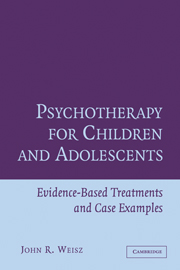Book contents
- Frontmatter
- Contents
- Preface
- SECTION A GENERAL INTRODUCTION
- SECTION B TREATMENTS FOR FEARS AND ANXIETY
- SECTION C TREATMENTS FOR DEPRESSION
- SECTION D TREATMENTS FOR ATTENTION DEFICIT/HYPERACTIVITY DISORDER
- Introduction to Section D: The Case of Kevin and Treatments for Attention Deficit/Hyperactivity Disorder
- 6 Using Behavioral Parent Training to Treat ADHD
- 7 Behavioral Programs for ADHD in Classroom and Camp Settings
- SECTION E TREATMENTS FOR CONDUCT PROBLEMS AND CONDUCT DISORDER
- SECTION F CONCLUSION
- References
- Author Index
- Subject Index
7 - Behavioral Programs for ADHD in Classroom and Camp Settings
Published online by Cambridge University Press: 06 July 2010
- Frontmatter
- Contents
- Preface
- SECTION A GENERAL INTRODUCTION
- SECTION B TREATMENTS FOR FEARS AND ANXIETY
- SECTION C TREATMENTS FOR DEPRESSION
- SECTION D TREATMENTS FOR ATTENTION DEFICIT/HYPERACTIVITY DISORDER
- Introduction to Section D: The Case of Kevin and Treatments for Attention Deficit/Hyperactivity Disorder
- 6 Using Behavioral Parent Training to Treat ADHD
- 7 Behavioral Programs for ADHD in Classroom and Camp Settings
- SECTION E TREATMENTS FOR CONDUCT PROBLEMS AND CONDUCT DISORDER
- SECTION F CONCLUSION
- References
- Author Index
- Subject Index
Summary
As we noted in Chapter 6, many experts believe that psychosocial treatment for ADHD needs to be located not in a therapist's office but in the settings where the affected youngsters live their lives, and where their performance deficits cause problems. Training parents to implement behavioral programs at home is one way to locate treatment in real-life settings (see Chapter 6), but behavioral programs have also been placed in settings where children are learning skills in the company of peers; such settings include school classrooms, summer camps, and weekend day programs – collectively labeled “classroom and camp” programs for the purposes of this chapter.
Behavioral classroom and camp programs aim for such goals as (1) improving attention to assigned tasks; (2) reducing overactive and impulsive behavior; (3) reducing disobedience and behavior problems at school; and (4) improving learning. The programs rely heavily on basic reinforcement principles. Typically, specific behavioral goals and objectives are identified for the child, a procedure is set up to monitor target behaviors, rewards are made contingent on the desired behaviors, and unattractive consequences are attached to unwanted behaviors such as disobeying, drifting off-task, or disrupting class. These consequences may be loss of points or chips in a token economy, loss of privileges (e.g., no outdoor time during recess), or brief time-outs. A number of creative approaches have been developed. For example, Rapport et al. (1982) found that salient cues were effective. They placed a small display counter (which teachers could access by remote control) on top of the desks of overactive children.
- Type
- Chapter
- Information
- Psychotherapy for Children and AdolescentsEvidence-Based Treatments and Case Examples, pp. 209 - 248Publisher: Cambridge University PressPrint publication year: 2004

